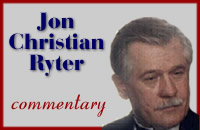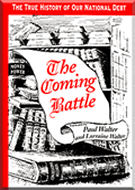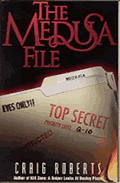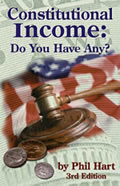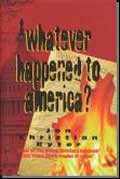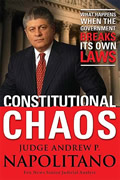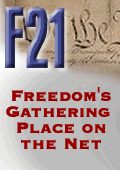Other
Ryter
Articles:
The Two Kerry's:
War Hero or
Traitor?
"Men in Black" The Cult of The Judges
READY
FOR THE CONGESTION TAX COLLECTOR?
By Jon Christian Ryter
June 14, 2005
NewsWithViews.com
During the Bush-41 years, the United States, England, Japan, Belgium, Germany, and Ireland embarked on an experimental vehicle tracking system designed for the 21st century. It was called the Intelligent Vehicle-Highway System or IV/HS. Ostensibly, it was designed to "lighten" traffic on heavily-used, smog-polluted roadways by assessing congestion taxes on the vehicles on the stressed roadways in order to "spread the traffic out" so that it moved faster with less pollutants spewing into the atmosphere during peak driving hours.
In reality, the purpose of IV/HS was to be able to control a population that Bill Clinton described in 1995 as, "...too highly mobile" by monitoring where that traffic was and, if necessary, by denying offending vehicles access to specific roads�or preventing residents of one State from traveling into another state without special "passes" or without paying a levy to do so. Because before any population can be controlled, government must know where that population is at any specific time. IV/HS was a theory that would have fit well in George Orwell's 1984 if the British New Worlder had entitled his book 1991 instead. Orwell only missed it by seven years.
It should be noted that IV/HS predated the Clinton Administration. George H.W. Bush initiated IV/HS in the United States with the Intermodel Surface Transportation Efficiency Act of 1991 at a cost of $151 billion over six years. Over $660 million of those dollars were earmarked for experimentation in IV/HS. Additional funds were set aside for building automated toll booths on private toll roads.
In April, 1992 Bush-41 issued an Executive Order on the privatization of state and local infrastructure assets built wholly or in part with federal money. (These assets, by definition, were roads, tunnels and bridges.) An interesting incentive�one that never made it into the evening news�appears in the EO. The Office of Management and Budget [OMB] "...had insisted that the federal government be repaid its past grants in the event the infrastructure was sold. The Executive Order does away with this disincentive. State and local governments will be able to keep the majority of the proceeds from privatization The Executive Order goes a long way towards removing any remaining blocks to action along the lines envisioned by ISTEA." (This document, interestingly, was found in the Clinton White House Health Care Interdepartmental Working Group; Working Paper #1, Box 1748; National Archive.) (Whatever Happened To America; Jon Christian Ryter � 2000; pg. 414)
What is most interesting is that IV/HS�like the national identity card that I warned was coming (in precisely the manner it showed up) in Whatever Happened To America�originated in Europe. Both are in use in Europe and Asia. The prototype from which the Diebold Institute cast its American model was borrowed from the pilot program in England where the experimental road system had already been installed in the heavily traveled M25 beltway around London. M25 was selected not only because of the amount of traffic on the roadway, but because the terrain was ideally suited for the constant measurement of speed�and the monitoring of specific vehicles.
The UK Department of Transportation was so pleased with the initial results, they expanded IV/HS into the arterials (A-roads) of London itself. The UK system, according to the Diebold Institute reports, had a dual purpose. First, TrafficMaster�as it became known�monitors traffic and electronically assesses speeding tickets, levied against the owner of the vehicle regardless who is driving it. Second, TrafficMaster serves as an electronic toll collector (just as electronic scanners on the Dulles Greenway around Washington, DC scan stickers on the windshields of cars and charge the toll to the vehicle owners' credit cards). Third, the electronic system can also be used to regulate assess to specific roadways by denying access to those roads at access ramps and road junctions during peak travel time, or denying access to those who fail to purchase a special "congestion travel time" pass�a congestion tax, if you will. In other words, during peak drive time, just as some freeways use HOV lanes (high occupancy vehicles lanes) to cut down on the number of vehicles on the road during those times, IV/HS can deny access to any vehicles without a "congestion" sticker on its windshield.
That was the proposal offered by London's mayor Kenneth Livingstone to a mayoral group from some of the world's largest cities that met at the Cable Car Museum in San Francisco on Friday, June 3 for the UN World Environment Day Conference where attendees discussed the impact fossil fuel smog has on global warming. Mayor Livingstone told the world mayors that Londoners�himself included�now pay a "congestion fee" to not only drive the M25 beltway, but to drive in central London. The daily fee is a Euro equivalent to US $9.
The $9 "voluntary" tax has forced thousand of Londoners out of their cars and into the now overcrowded city buses and subways to escape what blue collar workers feel is unjust tax that penalizes only the poor.
In San Francisco, commuters and tourists pay $3 to cross the Bay Bridge and $5 to cross the Golden Gate Bridge to enter into the city. However, commuters who live in the populous suburbs south of the city can enter downtown San Francisco free since they don't cross either bridge. However, even in ultra liberal, environmentalist-friendly San Francisco, Livingstone's tax message was not greeted with enthusiasm by the downtown merchants association who argued that a congestion tax will discourage shoppers who don't work in the city to pay what would amount to a "shoppers tax" for the privilege of fighting traffic and fighting for a parking space to shop. And, the merchants' associations argued, it will also discourage new retailers and other businesses from relocating into the city. "It would be a pricing mechanism that drives businesses out of downtown areas, " argued John Grubb of the Bay Area Council. "And," he added, "it would be a disincentive for businesses already downtown."
While American politicians will worry about the potential repercussions in the voting booth in liberal California where taxpayers are tired of footing the bill for everything and everyone, Livingstone gambled and won. He imposed the tax in London in 2003 and stood for reelection, and won, in 2004. Congestion pricing in London targets an eight-square mile area of central London that includes its financial and entertainment districts between 7 a.m. and 6:30 p.m., Monday through Friday. Britishers who plan to be in London must buy daily, weekly, or annual passes�and register their car's license plate numbers. A network of 800 cameras within the congestion zone photograph the license plates of every vehicle that passes it. Motorists who are not in the "registered" database for that day are fined.
In the United States, such a plan could be implemented easily since most major metro areas have already begun installed hundreds of "traffic" cameras at key intersections to boost for sagging revenues in municipal treasuries. Add to that the fact that the license plates on every American vehicle since 1992 can be tracked by global positioning satellites [GPS], and you have a system that would allow American "congestion controllers" to do everything the British system can do�and more. If Uncle Sam wanted, the government could actually write a physical ticket and, by GPs, let a meter maid deliver the ticket to you at the next red light you stop at. Of course, the profitability of congestion pricing comes from levying fines electronically and mailing the "summons" to your home. No human hands are involved in the process�except to arrest you if you fail to pay the ticket.
The most sinister aspect of IV/HS in the United States is the ability of the US government to covertly track any vehicle wearing a license plate stamped after 1992. The honing device, an electronic image stamped on the license plate when it was made, was to be a temporary tracking device until all vehicles on America's highways, byways and city streets, are equipped either with GPS or have some type of GPS chip installed somewhere unobtrusive under the hood of the car as a "non-theft devise." The electronic honing device was developed under a $20 million research grant during the Bush-41 years. (Whatever Happened To America; Jon Christian Ryter � 2000; pg. 415).
The electronic license plates scheme was global in nature. In the United States, the program was called HELP (Heavy Electronic License Plate). In Europe, the program was called LLAMD (London, Lyons, Amsterdam, Munich and Dublin) and is part of the international Drive System. In Japan the system was called VICS (Vehicle Information and Communications System). (ibid, pg. 415). People tracking will be a global effort, with all of the governments of the world sharing America's GPS network to monitor the movement of traffic and people.
Congestion taxing and the use of GPS to monitor the density of traffic on this nation's�or the world's�beltway systems in order to reduce traffic and smog around the world's largest metro centers has one question that begs an answer. For now, that question can remain unanswered. Why would the Clinton Administration jeopardize the national security of the United States in order to make GPS tracking available to the private sector to monitor the whereabouts of civilian vehicles on the roadways of America�or for that matter, allow the governments of all the nations of the world do the same in their nation...or use our GPS system to track us? GPS was so top secret that, according to former Bush-41 senior Pentagon advisor Henry Sokolski, the US government denied its existence�even to its allies�for over ten years.
|
Subscribe to the NewsWithViews Daily News Alerts! |
What happened between Jan. 20, 1993 when Bill Clinton took office and March 29, 1996 when Clinton granted civilian access to 24 GPS satellites to the world? I find it hard to believe that greenhouse gas emissions from fossil fuel cars justified the need to use GPS to regulate traffic on congested roadways around the world. It is more likely that the governments of the world suddenly had an empirical need to monitor a population that is too highly mobile. Oops...I just answered the question.
� 2005 Jon C. Ryter - All Rights
Reserved
Order Jon Ryter's book "Whatever Happened to America?"
Sign Up For Free E-Mail Alerts
E-Mails
are used strictly for NWVs alerts, not for sale
Jon Christian Ryter is the pseudonym of a former newspaper reporter with the Parkersburg, WV Sentinel. He authored a syndicated newspaper column, Answers From The Bible, from the mid-1970s until 1985. Answers From The Bible was read weekly in many suburban markets in the United States.
Today, Jon is an advertising executive with the Washington Times. His website, www.jonchristianryter.com has helped him establish a network of mid-to senior-level Washington insiders who now provide him with a steady stream of material for use both in his books and in the investigative reports that are found on his website.
E-Mail: BAFFauthor@aol.com
The most sinister aspect of IV/HS in the United States is the ability of the US government to covertly track any vehicle wearing a license plate stamped after 1992.

